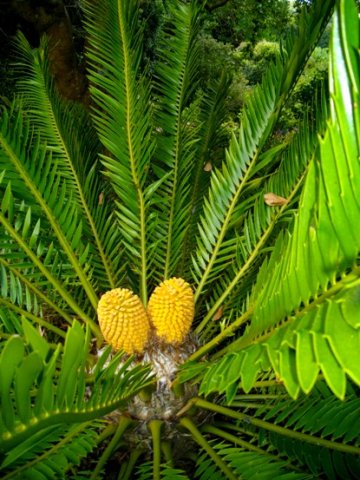Encephalartos msinganus

Author: Ivan Lätti
Photographer: Thabo Maphisa
Encephalartos msinganus, the Msinga cycad, grows a stem of up to 3 m in height, often surrounded by a clump of secondary stems from suckering (SA Tree List No. 14.7).
The leaves vary in length between 1,1 m and 1,5 m with straight to slightly arched rachises that are sturdy and green. Some twists of the rachis midsection do occur, also in the plant photographed. Leaflets, orientated upwards in a V-shape, twist sideways at an angle, their upper surfaces pointing towards the leaf tip. Leaflets become 14 cm to 17 cm long, their margins entire or toothed on either or both margins, while the lowermost leaflets are reduced to prickles. A thick edge is evident upon the lower parts of the leaflets.
Two female cones, pale yellow in colour, are positioned in the centre of the white stem crown, contrasting against the glossy dark green leaves.
The species is distributed in a small area of KwaZulu-Natal. This land in the Msinga district lies at altitudes between 900 m and 1200 m, in the catchment area of the Buffels River, a tributary of the Tugela.
The habitat is short grassland, the plant mostly found on steep north-facing slopes among sandstone rocks in clumps of scrub. The decline in the small habitat population renders it critically endangered early in the twenty first century. The threat mainly lies in illegal plant collection (Coates Palgrave, 2002; Hugo, 2014; http://www.iucnredlist.org; http://redlist.sanbi.org).

